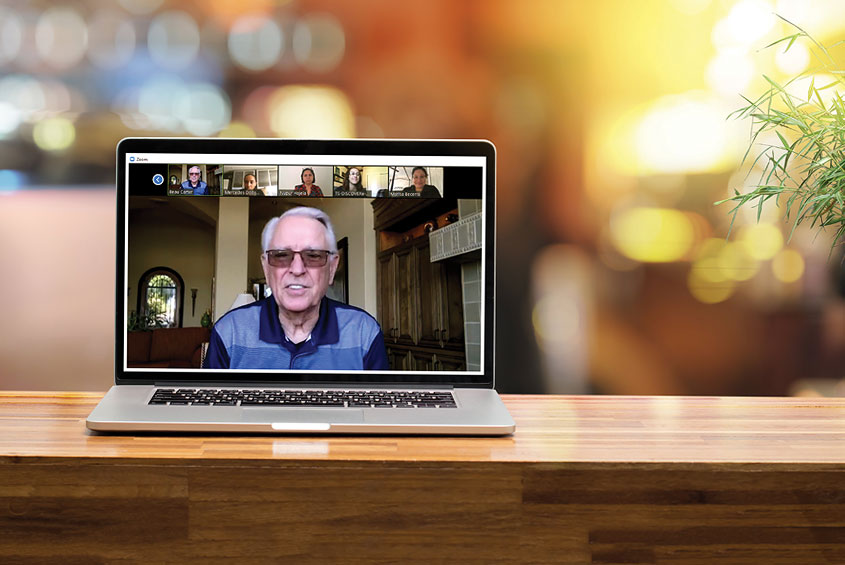Turning to Telehealth
Physical therapy clinic on campus goes virtual to continue helping patients
By Melissa Tav
A computer screen separates 78-year-old Fresnan Beau Carter from Fresno State physical therapy student Mercedes Dobson. They are in the middle of a gait and balance clinic appointment, and although the two are not physically in the same room, they can see each other clearly and interact in real time, thanks to the power of technology.
As the 30-minute session continues, Dobson gently instructs Carter to move his leg slightly to the left in an upward motion. Carter, who has weakness in his lower legs due to nerve issues and knee surgery, follows directions and holds his balance while one arm rests on the household chair in front of him.
Back in the virtual realm, Dobson, the lead therapist in this case, is joined by two classmates (serving as support therapists) and faculty supervisor Dr. Nupur Hajela, all of whom are viewing and analyzing the session from the comforts of their own homes. This method of providing health care electronically is known as telehealth — a method in which patients are connected to health care providers through remote means like video conferencing, image streaming and wireless communications.
Carter receives services through the Department of Physical Therapy’s Gait, Balance and Mobility Clinic, which provides low-cost treatment to local residents who have issues with movement due to a variety of neurological ailments, like traumatic brain injuries, stroke, Parkinson’s disease, multiple sclerosis and other surgeries. Before going virtual, the Gait, Balance and Mobility Clinic was held on campus twice a week and was led by second-year doctoral students in the physical therapy program, under the direction of faculty like Hajela, Dr. Na-hyeon (Hannah) Ko and three part-time clinical faculty.
With fast-moving changes due to COVID-19 causing the cancellation of in-person classes and a mandated shelter-in-place order by the City of Fresno, faculty had to work quickly to determine an alternative plan of action that would allow them to keep serving their clients (many of whom are elderly), while still maintaining the integrity of the learning experience for their students.
For a clinic built around hands-on learning, the transition was tough, but not impossible, Hajela says.
“With just a few weeks left in the semester, we knew it was important to continue offering this clinic for our patients and our students,” Hajela says. “We were pleasantly surprised at how quickly the students got on board and how nicely the patients and their caregivers supported this sudden change. We really tried to step up to the challenge, and it was really beautiful to see how well received this change has been.”
Of the clinic’s regular 32 clients, 14 agreed to continue on with the clinic via telehealth methods. Before this happened, the students first had to teach their clients how to go virtual, with both parties eventually adapting well to this new method.
“The transition was difficult at first, but overall, telehealth has been an interesting experience,” Dobson says. “Not all physical therapy programs have given their students the opportunity to experience it, so I’m fortunate that we are able to do it and still provide services to our patients so they can continue to make progress. I’m glad we’re learning it now, as it’s something we’ll need to utilize in the future. This experience is really helping us to be the best physical therapists we can be.”
According to the American Physical Therapy Association, telehealth is a health care practice that is quickly gaining traction in the field of physical therapy, especially in light of COVID-19 changing the landscape of health care worldwide. With many health care providers using this method during the pandemic, Hajela says she would not be surprised to see it increase in popularity over the next year.
For patients, the opportunity to stay engaged with students has many psychosocial benefits, particularly during a time when many elderly are isolated at home.
“One client mentioned he was very grateful to have this opportunity,” Ko says. “Due to the current situation and with his age, he is not able to leave the house, so the 30 minutes he gets to interact with students means so much more to him than just receiving physical therapy services.”
Before Carter and Dobson sign off their latest session, Carter is asked a series of questions by Dobson’s classmates. The telehealth usability questionnaire, as it’s called, is meant to gauge the patient’s satisfaction with the services.
When asked how he feels about the services, Carter’s answer is resounding.
“I’m really looking forward to next week!”
To learn more about the Department of Physical Therapy’s Gait, Balance and Mobility Clinic, contact nhajela@csufresno.edu or nko@csufresno.edu.






